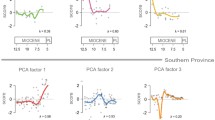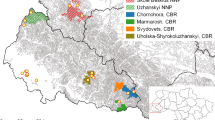Abstract
The distribution patterns of mouselike rodent species within the ecological space of the mountain forest of the southern Middle Siberia and the formation of multispecies communities are considered on the basis of our long-term research and literature data. The significant factors of the three-dimensional ecological space were identified by using multidimensional statistical analysis (multidimensional scaling, cluster and canonical discriminant function analyses). The differences in the sensitivity of species to environmental factors were shown to cause a divergence of their ecological niches, which ensures the independence of these species within their community.
Similar content being viewed by others
References
Abrosov, N.S., Kovrov, B.G., and Cherepanov, O.A., Ekologicheskie mekhanizmy sosushchestvovaniya i vidovoi regulyatsii (Ecological Mechanisms of Species Coexistence and Regulation), Novosibirsk: Nauka, 1982.
Aleksandrov, V.N. and Sergeev, V.E., Small mammals (Micromammalia) in Mountain Shoriya, in Fauna, taksonomiya, ekologiya mlekopitayushchikh i ptits (Mammals and Birds: Fauna, Taxonomy, and Ecology), Novosibirsk: Nauka, 1987, pp. 22–27.
Andreeva, T.A. and Okulova, N.M., Ecological preferences of forest voles, Russ. J. Ecol., 2009, no. 2, pp. 137–142.
Cook, R.P., Boland, K.M., and Dolbeare, T., Inventory of Small Mammals at Cape Cod National Seashore with Recommendations for Long-Term Monitoring, Boston, MA: National Park Service, U.S. Department of the Interior, 2006.
Giller, P.S., Community Structure and the Niche, London: Chapman and Hall, 1984. Translated under the title Struktura soobshchestv i ekologicheskaya nisha, Moscow: Mir, 1988.
Gromov, I.M. and Erbaeva, M.A., Mlekopitayushchie fauny Rossii i sopredel’nykh territorii. Zaitseobraznye i gryzuny (Mammals in the Fauna of Russia and Neighboring Countries: Rodents and Lagomorphs), St. Petersburg: Zool. Inst. Ross. Akad. Nauk, 1995.
Hutchinson, G.E., The niche: an abstractly inhabited hyper-volume, in The Ecological Theatre and the Evolutionary Play, New Haven, CT: Yale Univ. Press, 1965, pp. 26–78.
Ivanter, E.V. and Kukhareva, A.V., On the ecology of northern birch mouse (Sicista betulina) at the northern boundary of its range, Zool. Zh., 2008, vol. 87, no. 4, pp. 476–493.
Litvinov, Yu.N., Abramov, S.A., Krivopalov, A.V., Kovaleva, V.Yu., Novikov, E.A., and Chechulin, A.I., Structural-temporal organization of a rodent community in the Teletskaya taiga, Altai Mountains), Russ. J. Ecol., 2007, vol. 38, no. 6, pp. 413–418.
Meyer, B.J., Eccard, J., and Brandl, R., Vegetation structure and the abundance of the Black-Tailed Tree Rat Thallomys nigricauda at the Thornveld savannah (South Africa), in The Impact of Habitat Structures on Some Small Rodents in the Kalahari Thornveld (South Africa), Marburg: Philipps Univ. Press, 2004, pp. 65–77.
Michel, N., Burel, F., Legendre, P., and Butet, A., Role of habitat and landscape in structuring small mammal assemblages in hedgerow networks of contrasted farming landscapes in Brittany, France, Landsc. Ecol., 2007, vol. 22, no. 8, pp. 1241–1253.
Naumov, N.P., Studies on the mobility and abundance of small mammals using trench traps, in Voprosy kraevoi, obshchei i eksperimental’noi parazitologii i meditsinskoi zoologii (Problems in Regional, General, and Experimental Parasitology and Medical Zoology), vol. 9, Moscow: Medgiz, 1955, vol. 9, pp. 179–202.
Ogureeva, G.N., Strukture of altitudinal vegetation belts in the mountains of Southern Siberia, Byull. Mosk. O-va Ispyt. Prir., Otd. Biol., 1983, vol. 88, no. 1, pp. 66–74.
Polevaya geobotanika (Field Geobotany), Lavrenko, E.M. and Korchagin, A.A., Eds., Leningrad: Nauka, 1964, vol. 3.
Polikarpov, N.P., Chebakova, N.M., and Nazimova, D.I., Klimat i gornye lesa Yuzhnoi Sibiri (Climate and Mountain Forests of Southern Siberia), Novosibirsk: Nauka, 1986.
Puzachenko, Yu.G., Matematicheskie metody v ekologicheskikh i geograficheskikh issledovaniyakh (Mathematical Methods in Ecological and Geographic Research), Moscow: Akademiya, 2004.
Puzachenko, Yu.G. and Kuznetsov, G.V., Ecological differentiation of rodents in seasonally moist tropical forests of northern Vietnam, Zool. Zh., 1998, vol. 77, no. 1, pp. 117–132.
Puzachenko, Yu.G. and Kuznetsov, G.V., Tolerance of rodents to tree cutting in seasonally moist forests of southern Vietnam, Zool. Zh., 2003, vol. 82, no. 5, pp. 623–638.
Puzachenko, Yu.G., Pridnya, M.V., Martin, V., and Sankovskii, A.G., Representation of ecological niches of species for the mixed forest ecosystems of the Hubbard Brook basin (White Mountains, New England, North America), Russ. J. Ecol., 1996, no. 6, pp. 385–391.
Reimers, N.F., Ptitsy i mlekopitayushchie yuzhnoi taigi Srednei Sibiri (Birds and Mammals in Southern Taiga of Central Siberia), Moscow: Nauka, 1966.
Shvarts, E.A., Sheftel’, B.I., and Zhukov, M.A., Patterns of bank vole distribution in the south of species range, Byull. Mosk. O-va Ispyt. Prir., Otd. Biol., 1987, vol. 92, no. 2, pp. 17–26.
Sokolov, G.A., Mlekopitayushchie kedrovykh lesov Sibiri (Mammals in Siberian Stone Pine Forests of Siberia), Novosibirsk: Nauka, 1979.
StatSoft Inc. 2001. Statistica (data analysis software system), version 6.0. http://www.statsoft.com
Vinogradov, V.V., Melkie mlekopitayushchie Kuznetskogo Alatau (Small Mammals of the Kuznetsk Alatau Range), Krasnoyarsk: Krasnoyarsk. Gos. Ped. Inst., 2007.
Vol’pert, Ya.L. and Shadrina, E.G., Melkie mlekopitayushchie severo-vostoka Sibiri (Small Mammals of Northwestern Siberia), Novosibirsk: Nauka, 2002.
Yudin, B.S. and Nikolaev, V.V., Small mammal (Micromammalia) communities of vertical vegetation belts in the Central Eastern Sayan Range (Tofalaria), in Fauna i sistematika pozvonochnykh Sibiri (The Fauna and Systematics of Siberian Vertebrates), Novosibirsk: Nauka, 1977, pp. 81–92.
Yudin, B.S. and Potapkina, A.F., Territorial groups of small mammals (Micromammalia) in the Kuznetsk Alatau and Western Sayan Ranges, in Fauna i sistematika pozvonochnykh Sibiri (The Fauna and Systematics of Siberian Vertebrates), Novosibirsk: Nauka, 1977, pp. 32–59.
Yudin, B.S., Galkina, L.I., and Potapkina, A.F., Mlekopitayushchie Altae-Sayanskoi gornoi strany (Mammals of the Altai-Sayan Mountain Land), Novosibirsk: Nauka, 1979.
Author information
Authors and Affiliations
Corresponding author
Additional information
Original Russian Text © S.A. Abramov, V.V. Vinogradov, 2012, published in Povolzhskii Ekologicheskii Zhurnal, 2012, No. 4, pp. 363–375.
Rights and permissions
About this article
Cite this article
Abramov, S.A., Vinogradov, V.V. Ecological differentiation of mouselike rodents in the mountain forest belt of southern Middle Siberia. Biol Bull Russ Acad Sci 41, 833–841 (2014). https://doi.org/10.1134/S106235901410001X
Received:
Published:
Issue Date:
DOI: https://doi.org/10.1134/S106235901410001X




